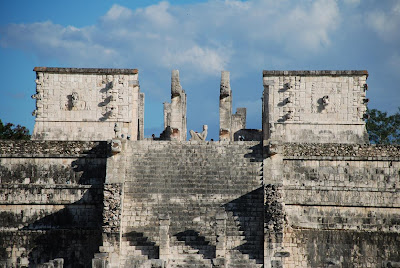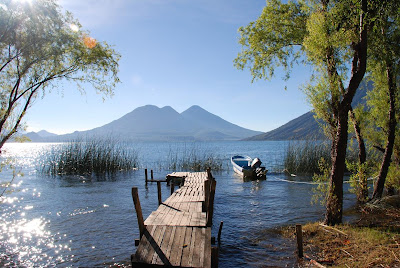The last group of animals that are regularly received at ARCAS are, of course, monkeys. There are 2 species of monkey that are normally received - the Yucatan (or Guatemalan) Black Howler Monkey, and the Spider Monkey. Each year a handful of howlers are received, and perhaps 15-20 spider monkeys are received. The majority of these animals, as per usual, come from seizures made at border checkpoints; a few have been kept as pets and are no longer wanted.
In my time at ARCAS there were probably around 60 spider monkeys in various groups, plus 6 howler monkeys overall - although when I left there were just 3 left. The 2 species respond very differently to captivity, so I'll deal with the Howlers first.
Guatemalan Black Howler Monkey
In Guatemala, black howler monkeys are endangered - as they are in the parts of Mexico and Belize where they still exist. There are larger concentrations of black howler monkeys in South America but they are of a different sub-species. They usually live in family groups of 7-10 animals in the wild. Their name comes from the incredible, distinctive howling that serves as their territorial warning. They produce the highest decibel noise of any land mammal, easily audible several kilometres away through thick jungle.

The average life span of any black howler in captivity is
three months: that's right, 3 whole months. They respond very poorly to the stress of captivity and suffer easily from diseases exacerbated by stress-related immunosupression. Since it's founding in 1989, ARCAS has singularly failed to release any single howler monkey into the wild, as all have died before reaching a rehabilitated stage. So far the most likely success story was in 1998, when a relatively happy group of 7 howlers were living together as a functioning troop. Then along came Hurricane Mitch, and a week of incessant rain brought on enough stress that 6 of the animals died due to related causes. The remaining animal died shortly afterwards due to the stress of being alone.
On my arrival at ARCAS there were 5 howlers in quarantine - 3 in a group (2 males and a female) that had been present for some time, and a pair of females by themselves (attempts to integrate them into one group had failed violently). Just a week after my arrival the female pari undid both the locks of their cages and escaped - never to be seen again. The hope is that they have left the near area - full of human habitation - and found other wild howlers to live with. The remaining three are still in quarantine, awaiting a decision on what to do with them from CONAP. Although theoretically they are too small to be released as a family group into the wild, given the experience with spider monkeys (see later) this could be an option. At the moment, one idea being mooted is to release them into the Education section of ARCAS where they will be least stressed.

One juvenile howler monkey arrived whilst I was at ARCAS. It had been captured a couple of months previously (this usually involves killing the mother), and was given up as it appear to be dying. And dying he surely was - 2 weeks after we took him on, he died of a variety of problems, including emaciation, possible kidney failure and likely hypothermia.
Spider Monkeys
As far as monkeys can be different, Spiders and Howlers are the opposite ends of the spectrum. Spider monkeys - not threatened in the wild - are one of nature's survivors, very adaptable, intelligent and resilient.
Since ARCAS began, there have been just 4 spider monkey releases, the most recent at the end of October with the biggest and most sophisticated rehab and release programme yet.

When juvenile monkeys arrive initially, they have to spend several weeks in individual quarantine to ensure they seem healthy. This is the most distressing part of the whole process - these are social, pack animals and being held in solitary confinement is not nice to see. Particularly young monkeys - up to the age of 12-15 months - need so tender love and care. Previous experience has shown that lack of contact and body warmth greatly decreases their survival rates. It is for this reason that you can see photos of me holding and feeding the baby - they take very well to their often-changing surrogate mums.
At about 15-18 months up to 3-4 years of age, the monkeys enter the juvenile monkey enclosure. At this stage, the pre-pubescent animals are a delight to behold and work with - friendly, curious, wanting to jump on you or snatch your broom. It makes being detatched - not talking to them, no playing, not allowing them to climb on you - very difficult. Group sizes tend to be 10-11 animals; when a group is large enough, another one is started.
Sexual maturity is reached at 3-4 years old (females first, males later) and this is when problems more usually start. Many monkeys kept as pets are no longer wanted when they reach this age, as they often become unpredictable and violent. Only ARCAS workers are alowed to enter cages with them; and as soon as space becomes available, they are moved to the Pre-Rehab enclosure(10x10x6m). Here they wait, in a larger enclosure with more environmental enrichment, until the large Rehab enclosure becomes free.
Upon leaving the quarantine pens and going to pre-Rehab, the physical and medical part of the rehab is done. What follows is the hardest part - behavioural rehabiliation. The hardest challenge is the development of a functioning troop; this is not sometinhg that can be engineered, but will or will not happen - the story of the recent release tells all. In the Rehab enclosure - 50m by 75m, complete with full sized trees and bounded by a wide treeless strip and electric fence - monkeys begin to behave something like they would in the wild, albeit in a much more limited area. They may spend up to 2-3 years in this enclosure before being ready to be released.
The recent release in October saw 2 groups go into the wild - one group of 7 from the Rehab enlcosure, and one group of 10 from the Pre-Rehab enclosure. The Rehab group had been there for 3 years, but did not have a strong social structure; the Pre-Rehab group had much less experience of living in trees but did have a strong troop structure - they were the first Spider monkeys in ARCAS history to breed in captivity. the objective of the dual release was to compare the importance of a long period in the Rehab enclosure with the importance of strong troop structure. In both groups of animals the dominant male and female were tagged with radio collars and all animals had their pale bellies dyed with identifying marks.

The previous 3 releases of Spiders from ARCAS had little follow-up information - the first 2 releases, in fact, had no follow up whatsoever. In the last release in 2002, a group of 2 males and 8 females were released on an island in a lake in a national park.In the summer that lake dried out and the group split up and went separate ways - the dominant male withthe young females and the juvenile male with the older females!
Spider monkeys, thanks to their adaptability, need to be released a long way from human habitation where they will quickly adapt to the lack of human presence (and feeding). If released close to humans, they will probably try to get food and end up dead or as a pet. The release this October was in Rio Azul National Park, probably the most remote region of Guatemala, where there are no roads (not even dirt ones!) for access, and incredibly few people.
After the release the groups have been followed solidly for 2 months, and will be followed intermittently for another 4. However, within a few days several things happened.
The Rehab group, with it's poor social structure, split up alomst immediately and began integrating with other monkey troops from surrounding areas. Three days later, the dominant female was seen in the company of another released female and a wild male, whilst the dominant male was seen with a 2 wild females.
The Pre-Rehab group fared better... for 24 hours. After being spotted the day after release as the original intact troop, the following day the radio collar of the dominant male was found amongst a pile of monkey hair, jaguar droppings and jaguar prints. The troop split up the same day and the dominant female later seen in the company of wild monkeys. It was theorised that the dominant male had slept too close to the ground as the Pre-Rehab perches were not that high - something we changed before puttting a new group in.

So what does that teach us? A survival rate of 60-70% amongst the released monkeys is hoped for as a "good" outcome; however, the rapid destruction of the social structres formed in captivity and apparently easy integration of monkeys into wild groups implies to me, at least, that perhaps too long is spent on trying to form group structures. There is importance to the social aspect seen at ARCAS - not least the ability to interact with other monkeys - and longer term survival studies should hopefully give an indication of the importance of the social/behavioural side of the rehab stage. It is clear, however, that rehabilitating any monkey is not easy and there will always be more to learn.



























